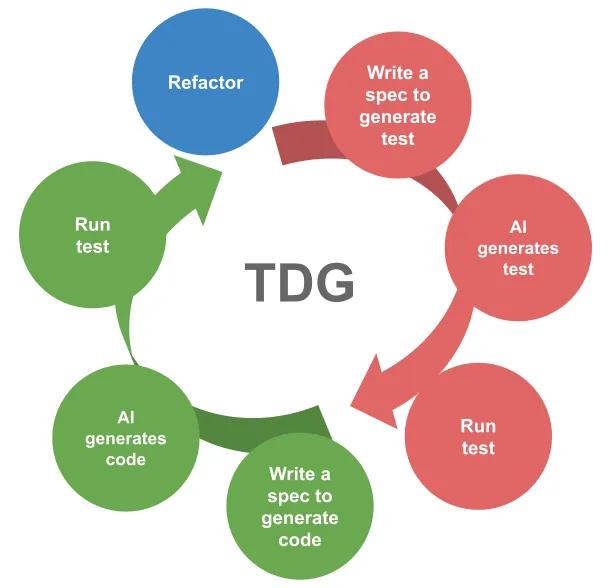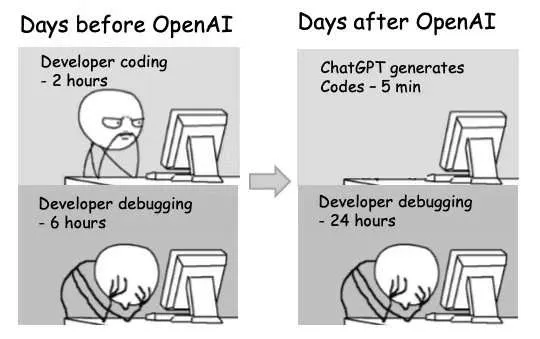Test-Driven Generation: Adopting TDD Again, This Time With Gen AI
TDG is an approach that combines TDD, Pair Programming, and Generative AI. It solves TDD challenges like slow initial development and steep learning curves.
Join the DZone community and get the full member experience.
Join For FreeYou know, over the past few years, software development has gone through some pretty exciting changes. New tools and methodologies have popped up, all aiming to make our lives easier, streamline processes, and boost code quality. One of the big players in this space has been Test-Driven Development (TDD). If you're not familiar, TDD is where developers write test cases for functionality before they actually write the code. It's a neat idea, but let's be real — TDD can be tough to get the hang of!
From my own experiences, I gotta admit: TDD is hard! It demands time, practice, and a whole lot of discipline to master. But here's the thing — the rise of Generative AI is opening up some awesome new possibilities to make this technique even better. By combining 1) TDD, 2) Pair Programming, and 3) Generative AI, I want to introduce you to a new approach: Test-Driven Generation (TDG).
So, What the Heck Is Test-Driven Generation?
Great question! TDG is an alternative development practice that brings generative AI right into the heart of the development life cycle. Instead of us, the human developers, writing both the tests and the code, we step into the role of specifiers. We outline the requirements and specifications, and then the AI takes over to generate the corresponding tests and code.
Wait a minute: you might be thinking,
"Aren't we already kinda doing that?"
Well, yes and no.
TDG is still based on the familiar principles of TDD, but with a twist: the developer pairs up with a generative AI model. This AI buddy takes on the heavy lifting of generating test cases and the code itself, leaving us to focus on the higher-level specs and logic.
The Test-Driven Generation: Red-Green-Refactor Loop

Here's how the process works:
- Spec definition: You provide a high-level specification or user story to the AI for test generation.
- Test generation: The AI whips up relevant test cases based on the specs you provided.
- Test execution: You run the tests. They'll fail at first because there's no code yet to pass them.
- Spec definition for code: You now give a specification for code generation.
- Code generation: Using feedback from the failing tests and your refined specs, the AI generates code to meet the test requirements.
- Test re-run: You re-run the tests. If they pass, great! If not, the AI refines the code until all tests pass.
- Iteration: You repeat this process, adding new specs, and the AI continues to generate additional tests and code until the entire program is fully developed.
As you can see, the loop isn't all that different from how we're currently using AI to generate code. The key difference is that this process still requires a bit of discipline from TDD — specifically, generating the test first, then the code.
The Benefits of TDG
By combining the strengths of generative AI with traditional development practices, TDG offers a ton of advantages over conventional methodologies like TDD and pair programming. Many of these benefits are inherited from the use of TDD but with some exciting new twists.
Faster Iterations
TDG speeds up the development cycle by offloading the tasks of writing code and tests to the AI. This allows us to focus on refining specifications and overseeing the development process rather than getting bogged down in the nitty-gritty coding details.
Higher Quality Code
Since the AI generates test cases right from the start, the code is inherently designed to meet those tests. This reduces the risk of missing edge cases or producing buggy code. It's like having a safety net that catches issues before they become problems.
Continuous Feedback Loop
TDG provides a constant feedback loop where we see test results immediately after the AI generates code. This allows for quick course corrections, ensuring that the code aligns with the evolving specifications. It also helps tackle the non-deterministic nature of AI code generation, making the whole process more predictable.
Less Cognitive Load on Developers
Using Generative AI is known to help reduce cognitive load, and TDG is no exception. We can focus on high-level design, architecture, and strategic problem-solving while letting the AI handle routine tasks like writing test cases and boilerplate code. This reduces fatigue and allows us to be more productive in the long run.
Tackling the Cons of TDD With TDG
I've known many teams that struggled to adopt TDD because of its inherent challenges. But with TDG, we can address several of these key drawbacks by leveraging Generative AI to automate many parts of the process. Here's how TDG can mitigate the major cons of TDD:
Slower Initial Development
TDD Con
Writing tests before writing the code adds overhead in the early stages of development, slowing down overall progress.
TDG Solution
With Generative AI, the AI automates test creation based on the high-level specs we provide. This eliminates much of the manual work involved in writing tests upfront, significantly reducing the time needed to kick off development. Instead of writing each test case manually, we focus on refining specs while the AI generates relevant tests.
Test Maintenance
TDD Con
As project requirements evolve, tests need to be updated frequently. Maintaining a large test suite can become a burden, especially if tests aren't written or maintained properly.
TDG Solution
The AI in TDG can automatically adjust test cases when specifications change, reducing the need for us to manually rewrite or adjust tests. This makes test maintenance more manageable by having the AI adapt to changes quickly, ensuring that tests stay aligned with evolving functionality.
Steep Learning Curve
TDD Con
TDD requires developers to have experience in writing effective tests, which can be difficult and time-consuming to learn, especially for newcomers.
TDG Solution
TDG reduces the learning curve by delegating the test-writing task to the AI. We don't need to master the art of test case writing to the same extent. We can focus on high-level design and logic, letting the AI handle the complexities of generating comprehensive test cases.
Requires Discipline and Team Buy-In
TDD Con
Successful TDD requires a high level of discipline and consistent practice from the entire team. If even a few team members don't follow the methodology rigorously, the benefits of TDD diminish.
TDG Solution
TDG automates a significant portion of the process, reducing the need for strict discipline. The AI can generate tests consistently, ensuring that no steps are skipped. This allows the team to focus on refining code and design while the AI maintains a consistent testing framework. TDG reduces the dependency on human discipline by making certain tasks automatic.
Why Consider TDG When Generative AI Can Already Generate Code?
You might be wondering,
"Why should we bother with TDG when Generative AI can already pump out code?"
That's a fair question, and here's why TDG stands out:
Ensuring Higher Code Quality and Reliability
While Generative AI can quickly produce code, it doesn't inherently guarantee that the code is correct, reliable, or meets all specified requirements. TDG incorporates the creation of test cases before code generation, ensuring that the AI-generated code is validated against these tests. This approach catches bugs and edge cases early, leading to more robust and reliable software.

Structured Development Process
TDG provides a structured workflow that integrates the principles of Test-Driven Development with Generative AI. This process ensures that development follows a clear specification-to-test-to-code sequence, maintaining the discipline of TDD but now powered by AI.
Reduced Debugging Time
By generating tests first, TDG helps identify issues at the earliest stage of development. This proactive approach reduces the time we spend on debugging and fixing errors after the fact. Simply generating code without accompanying tests can lead to more time spent diagnosing problems later on.
Wrapping Up
In summary, Test-Driven Generation (TDG) blends the best of Test-Driven Development (TDD), Pair Programming, and Generative AI to improve the development process. Instead of writing both the tests and code ourselves, we give the AI the specs, and it generates the tests and the code that passes them, one-by-one. This means we get clean, well-tested code faster while keeping the benefits of TDD to cut down on time spent debugging and fixing confusing errors.
So, what do you think? Would you like to give this TDG technique a try? Let me know in the comments below! I'm excited to hear your thoughts and experiences.
Published at DZone with permission of Chanwit Kaewkasi. See the original article here.
Opinions expressed by DZone contributors are their own.

Comments